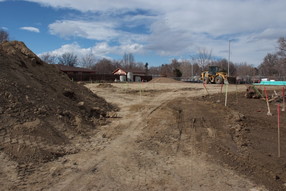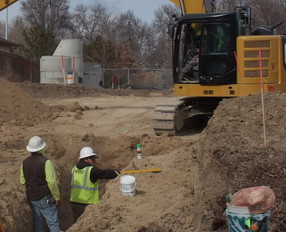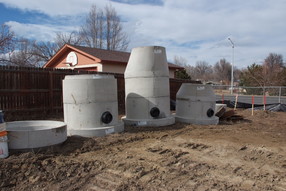|
IN THIS ISSUE
Did You Know?
A bright future for kids in Boulder County
Housing Affordability
Casa de la Esperanza: A house of opportunities, courage, and hope (Part 2)
ARPA funds make progress on housing affordability
Diversity, Equity, and Inclusion
A journey to center racial equity in the ARPA project in Boulder County
Boulder County ARPA Job Opportunities
|
|
Ver Contentido en Español
For previously published newsletters, go to boco.org/ARPA or click on this Newsroom link.
American Rescue Plan Act (ARPA) investments are making an impact in our Boulder County communities by providing resources to people who were hardest hit by the COVID-19 pandemic.
In this newsletter, we will share examples of the ARPA-supported work that is underway. We invite you to visit https://www.boco.org/ARPA
for additional information.
|
|
Boulder County’s ARPA newsletter is now published bimonthly. You will now receive the ARPA publication every two months, which will still include articles, news, and stories to keep you informed about the investment of federal ARPA funds in our communities. |
|
A bright future for kids in Boulder County |
|
|
Each day, the classrooms of the Boulder County Head Start Program are packed with music, smiles, circle time, healthy snacks and lunches, and lots of learning activities. Early childhood professionals at the Boulder County government's Community Services Department run this preschool program where children ages three to five can begin their early education without any cost to the parents.
"Besides the benefit of being a free full-day preschool during the school year, our program seeks to be responsive to all residents with different cultural backgrounds that qualify for our services, and it’s our mission and our value to adapt as the community adapts and changes," said Olivia Coyne, Boulder County coordinator for the Community Service Department and former HS division manager.
The integrated approach to school readiness helps low-income families by providing and connecting them with education, nutrition, health, social services, and other areas that will help children succeed in kindergarten.
"Families must be under the 100% federal poverty level, which for a family of four is about $30,000." However, the program provides some flexibility because they know the "one size fits all" approach for families in need is not the right one. "About 35% of our total enrollment can be between 100 and 130% of the federal poverty level, and 10% of our total enrollment can be above income," added Alex Linder, Family and Community Engagement Manager.
"We do everything we can to get families in the door," explains Coyne.
|
|
"If a child is in foster care or unhoused, we are not to turn them away. "The program goal is to find adequate resources for children to facilitate their integration with the school system.The spirit of collaboration is an integral part of the Head Start principles.
"The value of the program is in its very personal relationship with families in our community," explained Akane Orlandella Ogren, division manager of Boulder County Head Start.
"I can think of many teachers that text with parents and check in on how their child is doing now that they've left our program. They have this ongoing dialogue once the child moves into the school district." The program runs from August through May, with dates aligned with the Boulder Valley School District. Boulder County Head Start has four locations: two in the city of Boulder and two in Lafayette.
|
|
From the Head Start classroom to the Clyfford Still Museum |
|
|
From March to August 2022, the Clyfford Still Museum in Denver showcased its first show with the participation of young children. Students from the Boulder County Head Start Dagny classroom in Lafayette were selected to be part of this exhibition. In the show Clyfford Still, Art, and the Young Mind, visitors can see and hear children's interactions with art in English, Spanish, and American sign language. "With these opportunities, we also work to elevate the voices of the children and families we serve," says Coyne.
|
|
"Families went to see their children's words written on the walls. And there were all these stories about how parents just started crying because their child was in this institution, this art museum, the art gallery! And to see that the words of their own children were written on the walls had a huge impact on them," added Ogren.
More than 60% of the Head Start families speak Spanish, so the exhibition was an opportunity for the families to feel welcomed in a space where museum visitors could appreciate their backgrounds and cultures.
"We also work at a systemic level to think about access, equity, representation, and the influence of systemic racism or white norms, so through the duration of this project, at an administrative level, I was frequently meeting with the museum curators to talk about what I had learned as a white woman working in a program that largely serves the Latino population about white norms and barriers," added Coyne.
If you want to learn more about the program, you can send an email at hsenrollment@bouldercounty.org or call them at 720-564-2206.
|
|
Casa de la Esperanza: A house of opportunities, courage, and hope (part 2) |
|
Casa de la Esperanza is a 32-unit housing community in Longmont that has been home to agricultural workers and their families since the early 1990s. The Boulder County Housing Authority (BCHA) owns and manages the community, and its mission is to give its residents access to affordable housing options that will lower their cost of living and give them a sense of stability in their new neighborhood. Among the challenges that Casa de la Esperanza (House of Hope) residents face is getting used to a new community. To meet the needs of the families moving to Boulder County, the Casa de la Esperanza Learning Center was created.
"Residents needed a place where they could reach out for translation services, information, and tools for a smooth integration into the neighborhood, and a place where they could have a safe environment for their kids’ education," said Vanessa Arritola, Program Coordinator at Casa de la Esperanza. "I sit with the family, one-on-one, to explain each document. We're not just giving them a legal form without answering all their questions in their language of origin."
Access to community services can be hard for Spanish-speaking migrants, but Casa de la Esperanza has made it easier for household members who only speak Spanish to understand complicated legal rules.
The Casa de la Esperanza services offer a pathway for residents to become more independent, and the learning center provides educational, recreational, and academic opportunities, including onsite school tutoring and a cutting-edge robotics program focused on Science, Technology, Engineering, and Mathematics (STEM) education.
"Some of the highlights of our program are that we maintained a 100% graduation rate. Since 2009, every student who attended the same school district and participated in our program has graduated on time," added Arritola. "Of those students that graduate high school, we see about 50% of them pursue higher education, whether it's going into a trade program or going into a traditional community college or a four-year college. And we do have a few students who have gotten their master's as well."
|
|
|
"Some of the highlights of our program are that we maintained a 100% graduation rate. Since 2009, every student who attended the same school district and participated in our program has graduated on time," added Arritola. "Of those students that graduate high school, we see about 50% of them pursue higher education, whether it's going into a trade program or going into a traditional community college or a four-year college. And we do have a few students who have gotten their master's as well."
The educational center at Casa de la Esperanza provides resources for self-empowerment. One of the enrichment programs is robotics. STEM Educator and Technology Specialist Michael Lozano Roman noted, "this program started in 2007, but it was very expensive, so just a few schools had their own teams. We had the idea of starting a robotics group at Casa de la Esperanza to provide that opportunity for the students in our community. At that moment, we didn't have space to run the program, and most of the time we were using the biggest room that we have, which is the community room.”
Kids participate in competitions where each team must build a robot in six weeks. They decide on the robot prototype's design and program it to do a certain task. "Behind the programming and construction of the robot, they're learning a variety of skills such as coding, electrical engineering, mechanical engineering, time management, and project management," added Lozano. The program also uses art to further engage students in creative ways. "Students are fascinated with the program. They know they are going to build a robot, and with this challenge, they can discover their passion, their skills, and their strengths."
The center has helped low-income families in many ways with their schoolwork. It has done this through a variety of programs that have met the needs of this unique community.
Besides the STEM program, Casa de la Esperanza children can team up with the Cottonwood Institute for the Cottonwood Summer Program, as they create a foundation for kids to trek through nature and learn clear communication and interpersonal skills. The Rocket Club program is oriented toward getting middle school students to participate in a NASA-funded summer camp designed to get Casa de la Esperanza kids interested in math, science, and rockets.
Services for communities in need at Casa go beyond housing services and education. During the COVID-19 pandemic, they continued providing meals for food-insecure households. "We offer community food shares for families," added Arritola. Food distribution was a huge need during and after the pandemic, especially with the increasing prices for groceries. To learn about, donate to, or volunteer in the Casa de la Esperanza programs, go to https://www.casaesperanzalongmont.org/.
|
|
 The East Rogers Road development in Longmont is moving forward and making progress toward its goal of providing affordable housing for Boulder County communities in need.

|
The project is being built by Habitat for Humanity of the St. Vrain Valley (HFHSVV) partly with funds made possible by the American Rescue Plan Act (ARPA).
“This project will create nine new affordable housing units that provide homeownership for those who earn between $37,600 and $70,140 for a family of four,” said John Lovell, Director of Development for Habitat for Humanity of the St. Vrain Valley.
Construction crews are breaking ground to prepare for site layout and support the completion of the infrastructure needed to make real a project that will increase affordable housing options for our communities.
Funding made possible by ARPA “will contribute $800,000 to fund the anticipated costs for the construction of the infrastructure,” added Lovell.

|
|
|
As our neighborhoods, places of work, and community groups are more diverse in terms of race and ethnicity, governments are adapting to the changes shaping the future of our country. According to the 2020 US Census Bureau’s decennial data, people of color represented 43% of the total US population in 2020, up from 34% in 2010.
Boulder County has been working on transformational racial equity by designing and using plans to make an organization that is inclusive, multicultural, and anti-racist. With the creation of the Office of Racial Equity by the Boulder County Board of Commissioners (BOCC), the county continues to put race at the center of projects, plans, and policies.
|
|
|
“Oftentimes, we are taught not to talk about race, but we see repeatedly how that is impacting people's lives," said Kathy Sandoval, Racial Equity practitioner in Boulder County. The COVID-19 pandemic highlighted the persistence of inequities in education, housing and food insecurity, income, job stability, and health rights, to name a few. "We saw the disparate impacts the pandemic was having on frontline workers and Black, Indigenous and People of Color (BIPOC) communities; it was something that couldn't be ignored".
Boulder County’s Policy 1.6 was introduced in 2020 to center race in our equity work. As member of the Government Alliance on Race and Equity (GARE), Boulder County uses the Racial Equity Impact Assessment (REIAT) tool in the pandemic recovery approach and to help the Boulder County Board of Commissioners (BOCC) reach its strategic goals. "Too often, we've been socialized to be colorblind," added Sandoval. "Each one of our processes goes back to elevating racial consciousness on why race matters and normalizing the conversation."
Governments, nonprofits, businesses, and educational institutions can use the REIAT tool to understand a problem, revise the proposal or solution, explain the expected results, clear up questions, and understand how racial inequities may affect a project or decision. The tool helps Boulder County determine the fair investment of the American Rescue Plan Act (ARPA) funds. "We study the proposal more systemically. For example, access to childcare or affordable housing, and analyze how race may impact those programs," explains Sandoval.
For Marnie Huffman-Green, ARPA Mental Health and Social Resilience Project Manager, the tool is changing the way communities will receive mental health support: "I think it is a necessary first step towards ensuring that all programs receiving ARPA funds are anchored in conversations around equity and race. The racial equity tool and panel are essential if we truly want to create services and programs support the community in efforts towards racial equity. Furthermore, the REIAT tool asks extremely important questions to ensure projects are centered in equity. One question on the REIAT tool asks, ‘How will we ensure accountability, communicate and evaluate the results?’. This question, and all the 12 questions on the tool, ensure that programs are developed and communicated and evaluated to further the ARPA project’s commitment towards equity."
For Affordable Housing projects, centering race comes with a long history of structural barriers to economic equality that have been addressed since 1968 with the signature of the Fair Housing Act (FHA) by President Lyndon B. Johnson. FHA makes sure citizens have access to housing, regardless of race, national origin, sex, religion, disability, and familial status. The REIAT tool, along with racial equity training sessions for Boulder County staff, is a process to keep fighting those barriers and make a conscious decision to serve our communities in need with a different perspective. "We know there's a huge need to house people as quickly as possible. But there is also the need to respect the process," said Molly Chiang, Senior Developer at the Boulder County Housing Authority.
The REIAT tool can answer questions about diversity and inclusion when a decision affecting Boulder County residents is made. "There was a lot to think about in the process, from opening a building to making sure that residents are treated equally by eliminating barriers in the application," explained Chiang.
With ARPA funds, Boulder County is meeting the needs of its residents by creating programs to deal with the economic downturn, the need for affordable housing, and projects to help people find mental and social resilience that adapt to their needs. The use of the tool provides a different perspective in the development of policies, programs, and projects to combat the exclusion of communities in need.
|
|
|
Project Manager- Mobile Home Park
The Mobile Home Park Initiatives Project Manager is a new position that will report to the HHS Housing Partnerships and Policy Manager and will help align and coordinate county resources to better support mobile home park residents. The new hire will collaboratively identify, develop, and implement approaches to support the alignment of policies across Boulder County, increase mobile home park outreach and support for community organizing, increase case management and service navigation, and increase opportunities for the repair, restoration, rebuilding, or transformation of mobile home parks. To learn more about this opportunity, go to Boulder County Careers.
|
|
|
|
|